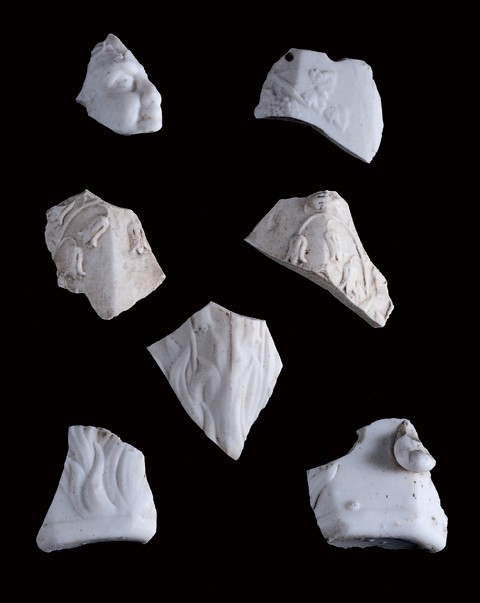
Miscellaneous ceramic fragments recovered from the U. S. Pottery Co. site during 1997 and 1998. Top, left to right: parian porcelain curtain tie-back, parian porcelain door plate. Middle, left to right: parian porcelain sailor boy with dog figurine, earthenware cow creamer. Bottom, left to right: yellow ware fleur de lis. (Courtesy, Bennington Museum; photo, Gavin Ashworth.)

Pitcher fragments of parian porcelain in the Lily of the Valley pattern recovered from the U. S. Pottery Co. site during 1997 and 1998. (Courtesy, Bennington Museum; photo, Gavin Ashworth.)

Pitcher, Lily of the Valley pattern, U. S. Pottery Co., Bennington, Vermont, 1853–1858. Parian porcelain. H. 4 1/2". (Private collection; photo, Jay Lewis.) Upon hearing a description of this newly discovered design, a prominent American ceramic collector furnished this photograph of the complete pitcher, now confirmed to have been made at the U. S. Pottery Co.
For several weeks during 1997 and 1998, project director Catherine Zusy, archaeologists David Starbuck and Victor Rolando, and over seventy volunteers excavated at the U.S. Pottery Company (1847–1858) site in Bennington, Vermont. The goal of the project was to learn more about the production of Christopher Webber Fenton’s pottery—the first large production pottery in New England and possibly the first in the nation to produce parian porcelain figures. While many have written about the factory and its products, there remains much confusion about what it made, especially in regard to parianware. The pottery marked little of its parian (no figures are known to be marked), published no illustrated price lists, and employed English designers who regularly copied English forms.
Bennington Elementary School now sits on top of the site of the former factory, so most pits were dug to the south of the school, blacktops, and playgrounds, just south of the 1853 wing of the pottery building. These excavations produced over 18,000 bits of kiln furniture, and more than 27,000 ceramic fragments were unearthed, including bisque earthenware (12,291); parian (8,488); Rockingham and int enamel (3,139); yellow and white wares (2,017); and agateware (309). Most of the earthenware fragments were of forms previously documented as Bennington, of which there are many marked pieces of the firm’s earthenware.
Over half of the parian shards could be identified as fragments of twelve documented Bennington parian pitcher designs: Pond Lily; Wild Rose; Tulip and Sunower; Palm Tree or Paul and Virginia; Charter Oak; Arabesque; Cascade; Acanthus; Climbing Ivy; Flower and Vine; and Bird and Nest. Unknown variations of four of the pitchers— Charter Oak, Wild Rose, Ivy Vine, and Acanthus Leaf— were found, but not fragments of the documented pitchers Love and War and Snowdrop.
Fragments of a parian doorplate, doorplate letter, doorknob, curtain tie-back and one figure (probably Sailor Boy and Dog) were found—all items listed on a company price list dated 1852, but not firmly identified until now (fig. 1). The 1852 price list is the last one extant for the company and the only one that includes parian, enumerating eleven figures in “parian marble.” The firm made parian statuettes, vases, and clockcases until at least 1856. Also found were fragments of porcelain insulators and a blue and white cane handle in the shape of the head of an old bearded man. Only one possible vase fragment was unearthed, and no trinket box fragments were uncovered.
Perhaps of greatest interest was the discovery of 112 sherds of a small paneled parian pitcher design not yet identified with Lily of the Valley design (figs. 2, 3). Four other new earthenware forms were discovered: a pitcher with fleur de lis design; a sugar bowl or teapot with foliage and grape decoration; a hanging planter with acanthus leaf handles; and an agateware form, probably a pitcher, with a double diamond decoration. In addition, twelve designs previously only attributed to Bennington were found: the parian objects noted above and, in earthenware, a hound-handled pitcher, cow creamer, candlestick, candlestand, raspberry ask, pedestal goblet, tumbler, and spittoon with shell decoration. Seventy-five “mystery” fragments were also recovered, including over eighteen handles.
At least ten forms documented as products of the U.S. Pottery Company were not found, and only one or two fragments of the firm’s renowned hound-handled pitcher and cow creamer were. While these preliminary excavations add to our knowledge of the factory’s production, they by no means complete it, as less than one percent of the four-acre site was examined. Furthermore, the two schools that have subsequently been erected there have disturbed the site, and it is likely that the factory was dumping elsewhere as well. Future research including archaeology, historical research, and scientific study is needed to complete the story of the United States Pottery Company.[1]
ACKNOWLEDGMENTS
The author wishes to thank the American Ceramic Circle for providing major financial support for the 1998 excavations.
Catherine Zusy
Ceramics Specialist and Consultant
CathZusy@aol.com
Victor R. Rolando and Catherine Zusy, “Archeology at the United States Pottery Co. Site in Bennington, Vermont,” The Journal of Vermont Archaeology 3 (2000): 86–114.
